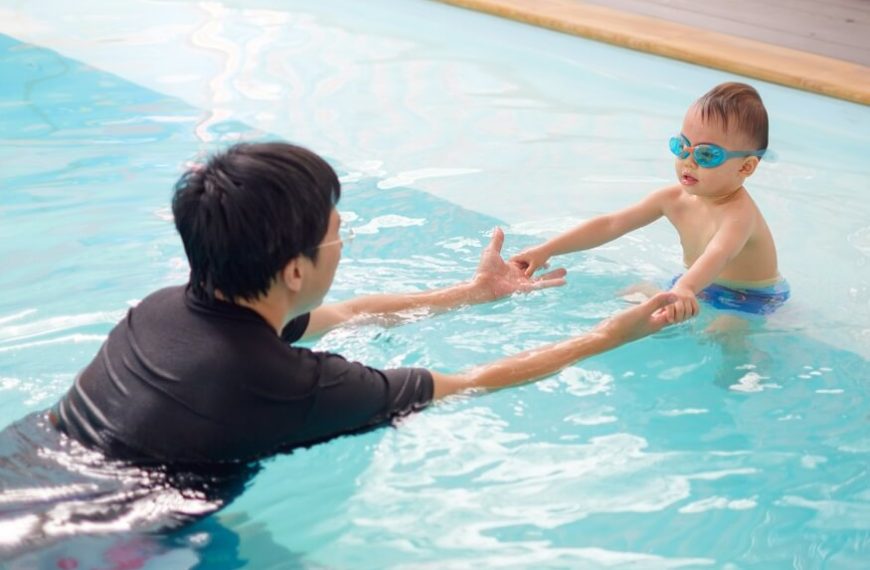Swimming is not just a skill; it’s a life-saving ability and a source of joy. Teaching your child to swim is a valuable gift that combines physical activity with essential life skills. In this comprehensive guide, we’ll walk you through the step-by-step process of imparting the art of swimming to your little one.
- Understanding the Importance of Swimming Education
- Initiating the Journey: When to Start?
- Setting the Stage: Create a Positive Environment
- Gradual Introduction: The First Steps into Water
- Familiarizing with Water: Basic Floating Techniques
- Submersion and Breath Control: A Fundamental Skill
- Learning the Basics: Freestyle and Backstroke
- Safety First: Water Safety Education
- Advanced Techniques: Breaststroke and Butterfly Stroke
- Building Endurance: Fun Exercise for Children
- Consistent Practice: Regular Swimming Lessons
- Water Confidence: Overcoming Fear and Anxiety
- Understanding Water Resistance: The Science Behind Swimming
- Diving into Diving: Introducing Headfirst Entries
- Developing Water Awareness: Environmental Factors
- Mastering Treading Water: A Fundamental Survival Skill
- Encouraging Peer Interaction: Group Swimming Activities
- Transitioning to Open Water: Lake and Ocean Swimming
- Continuous Learning: Advanced Swimming Classes
Before diving into the practical aspects, it’s crucial to grasp why teaching your child to swim is essential. Besides being a recreational activity, swimming enhances physical fitness, promotes water safety, and boosts confidence. The ability to swim is a lifelong asset, making it imperative for parents to prioritize swimming education.
The right age to start swimming lessons varies, but a general consensus suggests that introducing your child to the water at an early age can yield positive results. Most experts recommend starting formal swimming lessons around the age of four, but familiarizing your child with water in a playful manner can begin much earlier. Always gauge your child’s comfort level and readiness before embarking on formal instruction.
Establishing a positive association with water is crucial. Begin with shallow pools or calm, natural bodies of water. Ensure the temperature is comfortable, and use flotation devices when needed. Create a relaxed atmosphere to minimize anxiety and encourage enthusiasm for the learning process.
The initial contact with water should be gradual and gentle. Start by letting your child play in shallow water, allowing them to splash and explore at their own pace. Gradually progress to deeper water, all while maintaining constant communication to build trust and confidence.
Teach your child the fundamentals of floating, a crucial skill in swimming. Begin with simple back floats, guiding them to relax and trust the buoyancy of water. This step establishes a foundation for more advanced swimming techniques.
Introduce the concept of submersion gradually. Encourage your child to put their face in the water, teaching them breath control. This step is pivotal for developing confidence and preparing them for more complex strokes.
As your child becomes comfortable in the water, introduce basic swimming strokes. Focus on freestyle and backstroke, emphasizing proper arm and leg movements. Repetition and practice are key to mastering these foundational techniques.
Teaching your child about water safety is as important as the swimming skills themselves. Ensure they understand basic safety rules, such as not swimming alone, avoiding running around pools, and recognizing lifeguards.
Once your child has mastered the basics, progress to more advanced strokes like breaststroke and butterfly. Break down each movement, providing constructive feedback to refine their technique. Consistent practice is vital for honing these skills.
Make swimming an enjoyable exercise for your child. Design fun and challenging activities to improve their endurance and stamina. Games like underwater treasure hunts or timed laps not only enhance physical fitness but also make the learning experience exciting.
Consistency is key to skill development. Enroll your child in regular swimming lessons to provide structured guidance and progression. Professional instructors can offer valuable insights, correct techniques, and monitor your child’s overall swimming development.
Addressing any fear or anxiety your child may have about water is crucial for a successful swimming journey. Start with gentle encouragement, positive reinforcement, and gradual exposure. Avoid pushing your child too quickly; instead, let them progress at their own pace. Building water confidence early on is foundational for future swimming success.
Explaining the science behind swimming can make the learning process more engaging for your child. Discuss concepts like buoyancy, water resistance, and body position. Understanding these principles not only enhances their swimming skills but also sparks curiosity and a deeper appreciation for the activity.
Once your child is comfortable with basic floating and submersion, introduce headfirst entries. Teach them the proper technique for diving, emphasizing the importance of a streamlined body position. This skill adds an element of excitement to their swimming repertoire and prepares them for more advanced aquatic activities.
Educate your child about the various environmental factors they might encounter while swimming, such as waves, currents, and varying water depths. Instill an awareness of their surroundings and teach them how to adapt their swimming techniques based on different conditions. This knowledge contributes to their overall water competency.
Treading water is a valuable skill that enhances both confidence and safety. Teach your child the proper techniques for treading water, emphasizing controlled movements and rhythmic breathing. This skill is particularly important for situations where swimming for an extended period is required.
Engage your child in group swimming activities to foster social interaction and teamwork. Group lessons or swimming with friends can make the learning experience more enjoyable and provide opportunities for peer encouragement. Socializing in a water environment contributes to a positive and supportive swimming experience.
If your child has mastered swimming in pools, consider introducing them to open water environments like lakes or oceans. Teach them about the differences in water conditions and potential challenges. Always prioritize safety and supervision in open water settings, ensuring a smooth transition from pool to natural water bodies.
As your child progresses, consider enrolling them in advanced swimming classes. These classes often cover specialized strokes, rescue techniques, and advanced water safety skills. Expert instructors can provide tailored guidance to further refine their swimming abilities.
Teaching your child to swim is a journey that combines physical activity, safety awareness, and the joy of mastering a valuable skill. By following these step-by-step instructions, you’re not only imparting the ability to navigate water confidently but also fostering a love for an activity that promotes overall well-being.
For a holistic approach to your child’s development, consider enrolling them in EuroKids. Our expert educators understand the importance of a well-rounded education, encompassing not only academics but also essential life skills. Visit our website to explore our programs and give your child the gift of comprehensive learning.















